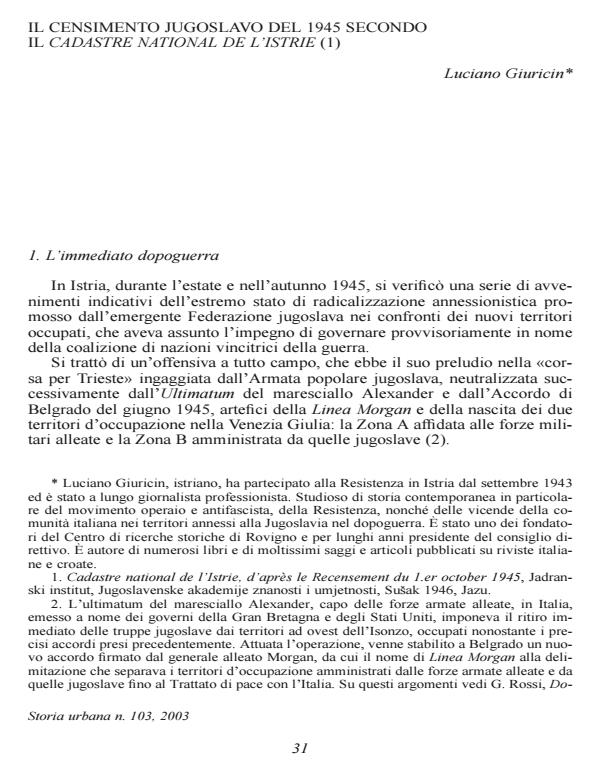Il censimento jugoslavo nel 1945 secondo il Cadastre National de l'Istrie
Titolo Rivista STORIA URBANA
Autori/Curatori Luciano Giuricin
Anno di pubblicazione 2004 Fascicolo 2003/103
Lingua Italiano Numero pagine 15 P. Dimensione file 57 KB
DOI
Il DOI è il codice a barre della proprietà intellettuale: per saperne di più
clicca qui
Qui sotto puoi vedere in anteprima la prima pagina di questo articolo.
Se questo articolo ti interessa, lo puoi acquistare (e scaricare in formato pdf) seguendo le facili indicazioni per acquistare il download credit. Acquista Download Credits per scaricare questo Articolo in formato PDF

FrancoAngeli è membro della Publishers International Linking Association, Inc (PILA)associazione indipendente e non profit per facilitare (attraverso i servizi tecnologici implementati da CrossRef.org) l’accesso degli studiosi ai contenuti digitali nelle pubblicazioni professionali e scientifiche
The essay deals with the main events involving Venezia-Giulia, the Istrian peninsula and Fiume (Rijeka) in the aftermath of WW II. The study focuses on one specific event: the unofficial census of the Istrian population carried out in October 1945 to prove the Slav character of the peninsula and thus help to tip the balance, at the Paris Peace Conference, in favour of Yugoslavia in the border dispute with Italy. The study of this anomalous census from every viewpoint points out its several inconsistencies and irregularities, both during the counting operation - planned secretly and carried out by indirect means, i.e. through parish and municipal registers - and upon publication of the count results in the Cadastre national de l’Istrie, where out of a total of 337,408 inhabitants, 234,166 were reported to be of Slav origin (69.4%) and 92,788 of Italian origin (27.5%). The same proportion was found in the survey concerning the distribution of Slav vs. Italian surnames and toponyms. It should be noted that a comparison with previous censuses was made taking into account the official Austrian censuses of 1880, 1890, 1900 and 1910, whereas the Italian 1921 census was thoroughly ignored, as if it had never existed. Moreover, the Fiume municipality was excluded from the 1945 census. The inclusion of Fiume could have produced a significant shift in the regional ethnic balance in favour of the Italian community. As for Pola, then under Anglo-American rule, the count was made on the basis of estimates and projections from the Austrian 1910 census, which were also published in the Cadastre. One of its most outstanding flaws is the later correction to get round the problem of the so-called Indeterminates of the Buie area (approx. 30% of the overall population). The census of that area was repeated in February 1946, when the majority of indeterminates declared to be Croats. The manipulations become all the more visible by comparing the 1945 count with the first official Yugoslav survey of 1948, when many Istrian areas reported a significantly higher concentration of Italians in comparison to 1945 in spite of the substantial exodus that had occurred in the meantime.
Luciano Giuricin, Il censimento jugoslavo nel 1945 secondo il Cadastre National de l'Istrie in "STORIA URBANA " 103/2003, pp , DOI: